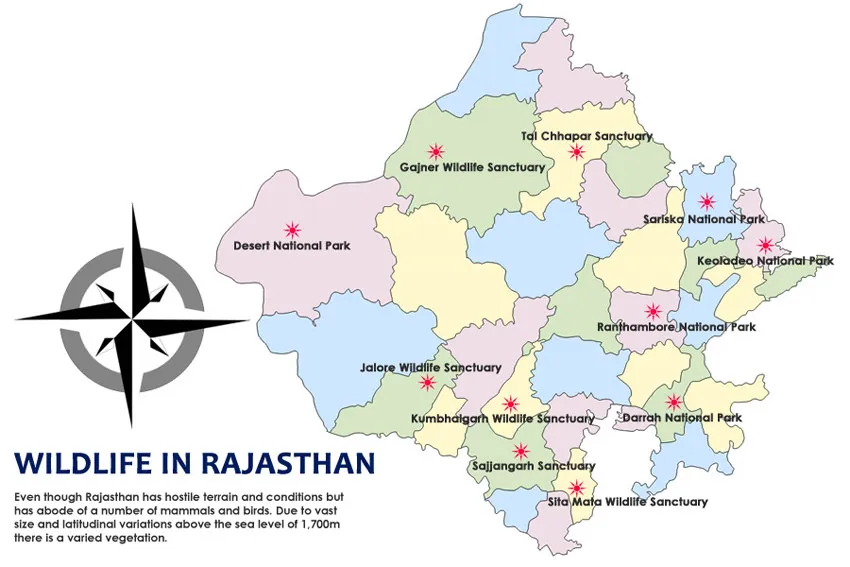Tal Chhapar Sanctuary | 20 Dec 2022
Why in News?
Recently, the famous Tal Chhapar Blackbuck Sanctuary in Churu, Rajasthan received a protective cover against a proposed move of the State government to reduce the size of its Eco Sensitive Zone (ESZ).
- The World Wildlife Fund for Nature (WWF) has also taken up a major project for the conservation of raptors in the sanctuary, spread in an area measuring 7.19 sq. Km.
What are the Key Facts about Tal Chhapar Sanctuary?
- About:
- The Tal Chhapar Sanctuary is situated on the border of the Great Indian Thar Desert.
- Tal Chhapar is a distinctive shelter of the most graceful Antelope seen in India, “the Blackbuck”.
- It was given the status of a sanctuary in 1966.
- Tal Chhapar was a hunting reserve of the erstwhile royal family of Bikaner.
- The “Tal” word is Rajasthani word means plane land.
- This Sanctuary has nearly flat territory and combined thin low-lying region. It has got open and wide grasslands with spread Acacia and Prosopis plants that offer it a look of a characteristic Savanna.
- Fauna:
- Tal Chhapar is an ideal place to see Blackbucks which are more than a thousand in number here. It is a good place to see the desert animals and reptile species.
- The sanctuary is host to about 4,000 blackbucks, over 40 species of raptors and more than 300 species of resident and migratory birds.
- Migratory birds in the sanctuary are harriers, eastern imperial eagle, tawny eagle, short-toed eagle, sparrow, and little green bee-eaters, black ibis and demoiselle cranes. Other than that, skylarks, crested larks, ring doves, and brown doves can be seen throughout the year.
What are Blackbucks?
- About:
- The Blackbuck (Antilope cervicapra), or the Indian Antelope, is a species of antelope native to India and Nepal.
- It is widespread in Rajasthan, Gujarat, Madhya Pradesh, Tamil Nadu, Odisha, and other areas throughout peninsular India.
- It is considered as the epitome of grassland.
- The blackbuck is a diurnal antelope (active mainly during the day).
- It has been declared as the State Animal of Punjab, Haryana, and Andhra Pradesh.
- Cultural Importance: It is a symbol of purity for Hinduism as its skin and horns are regarded as a sacred object. For Buddhism, it is a symbol of good luck.
- The Blackbuck (Antilope cervicapra), or the Indian Antelope, is a species of antelope native to India and Nepal.
- Protection Status:
- Wildlife Protection Act 1972: Schedule I
- IUCN Status: Least Concern
- CITES: Appendix III
- Threat:
- Habitat Fragmentation, Deforestation, Natural Calamities, Illegal Hunting.
- Related Protected Areas:
- Velavadar Blackbuck Sanctuary - Gujarat
- Point Calimere Wildlife Sanctuary - Tamil Nadu
- In 2017, the Uttar Pradesh State Government approved the plan of setting up the Blackbuck Conservation Reserve in the trans-Yamuna belt near Prayagraj. It would be the first conservation reserve dedicated to the blackbuck.
What are Eco-Sensitive Zones (ESZs)?
- ESZs are areas notified by the Ministry of Environment, Forest, and Climate Change (CC), under the Environment Protection Act, 1986.
- The basic aim is to regulate certain activities around National Parks and Wildlife Sanctuaries so as to minimise the negative impacts of such activities on the fragile ecosystem encompassing the protected areas.
- In June, 2022, the Supreme Court directed that every protected forest, national park and wildlife sanctuary across the country should have a mandatory eco-sensitive zone (ESZ) of a minimum one km starting from their demarcated boundaries.
UPSC Civil Services Examination, Previous Year Questions (PYQs)
Q1. Which one of the following protected areas is well-known for the conservation of a sub-species of the Indian swamp deer (Barasingha) that thrives well on hard ground and is exclusively graminivorous? (2020)
(a) Kanha National Park
(b) Manas National Park
(c) Mudumalai Wildlife Sanctuary
(d) Tal Chhapar Wildlife Sanctuary
Ans: (a)
Exp:
- Hard ground swamp deer or Barasingha (Rucervus duvaucelii), the state animal of Madhya Pradesh, is seeing a revival in the Kanha National Park and Tiger Reserve (KNPTR).
- Swamp Deer was close to extinction in the Kanha National Park. However, with the conservation efforts, the population currently numbers around 800.
- The deer is endemic to the Kanha National Park and Tiger Reserve on the Maikal Range of Satpura Hills. Measures like captive breeding and habitat improvement were used.
- Therefore, option (a) is the correct answer.
Q2. With reference to ‘Eco-Sensitive Zones’, which of the following statements is/are correct? (2014)
- Eco-Sensitive Zones are the areas that are declared under the Wildlife (Protection) Act, 1972.
- The purpose of the declaration of Eco-Sensitive Zones is to prohibit all kinds of human activities in those zones except agriculture.
Select the correct answer using the code given below:
(a) 1 only
(b) 2 only
(c) Both 1 and 2
(d) Neither 1 nor 2
Ans: (d)

